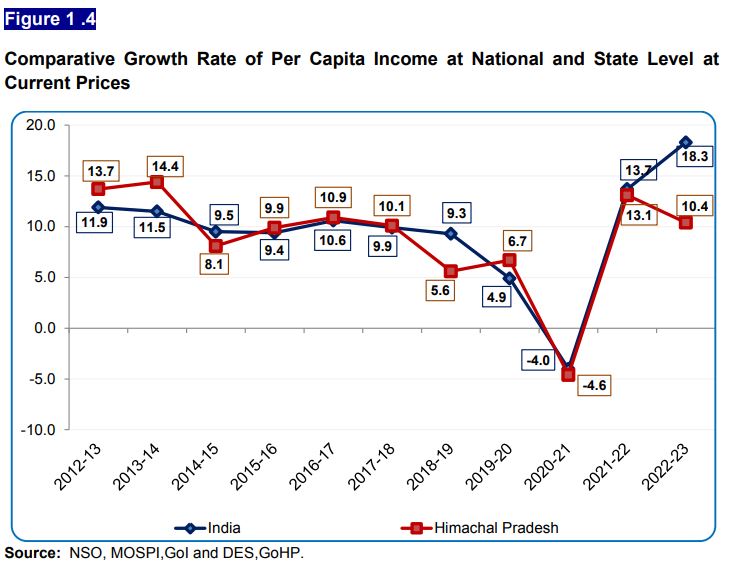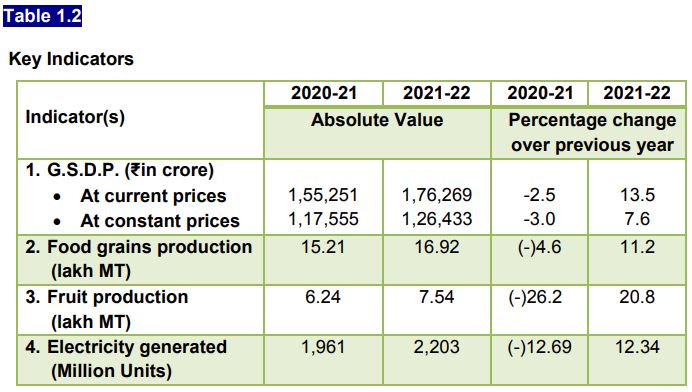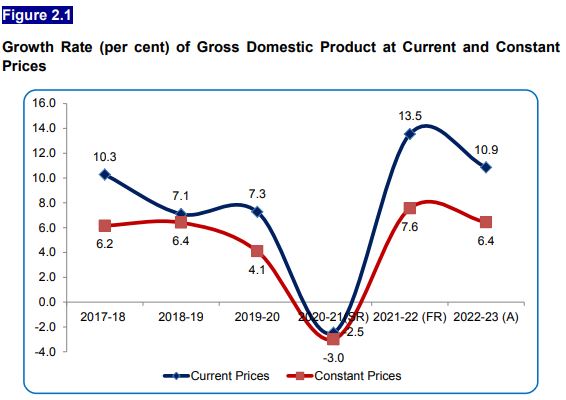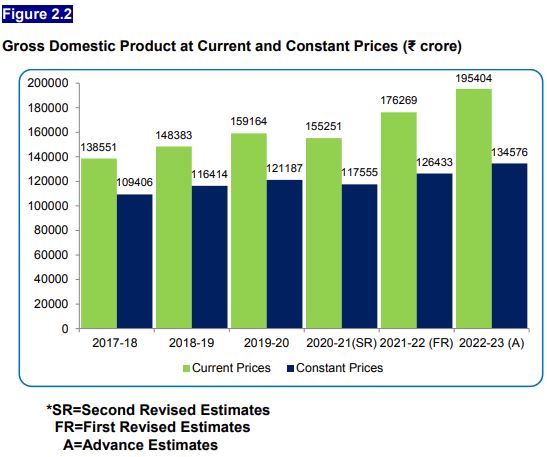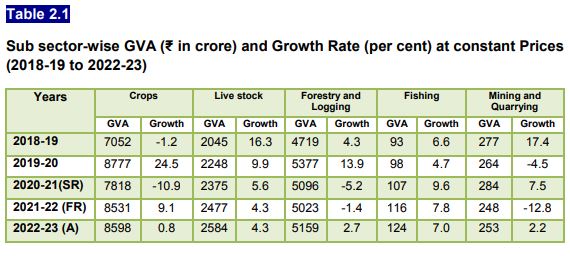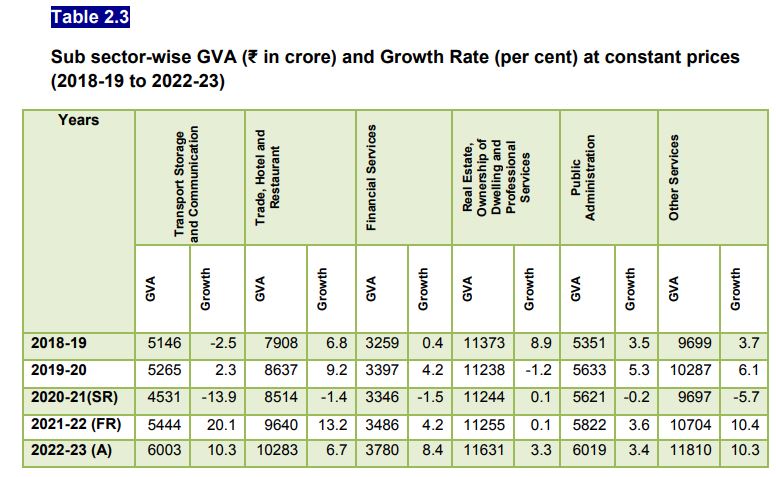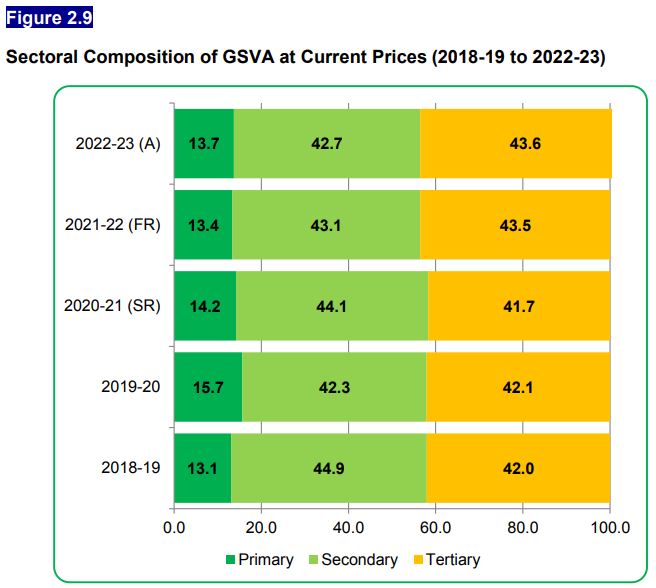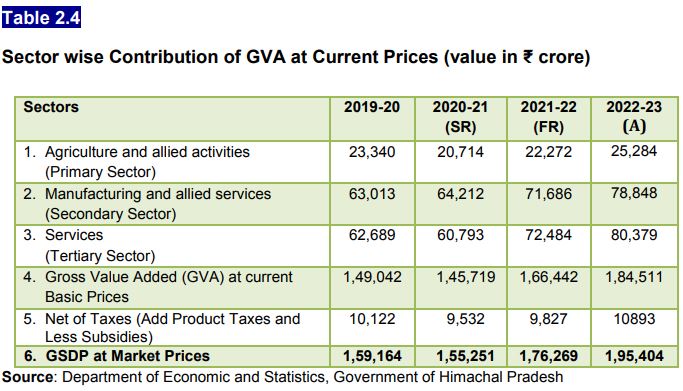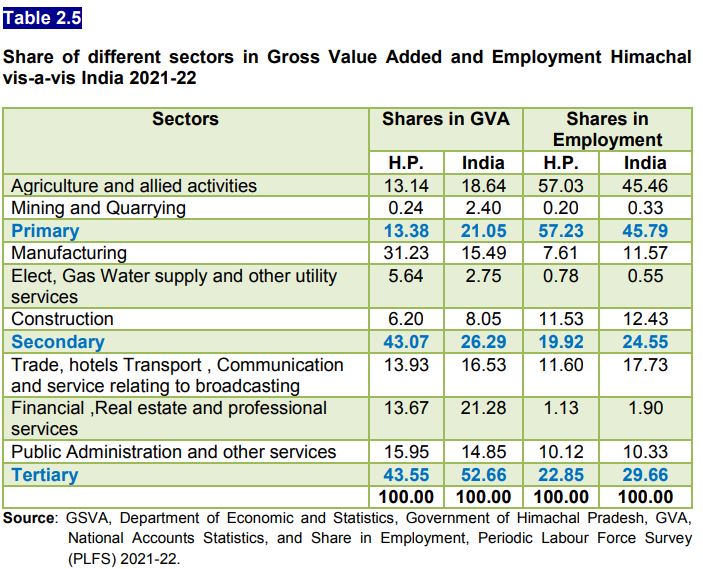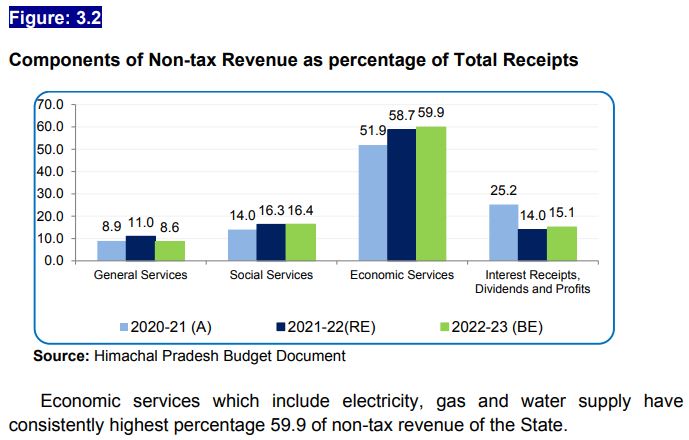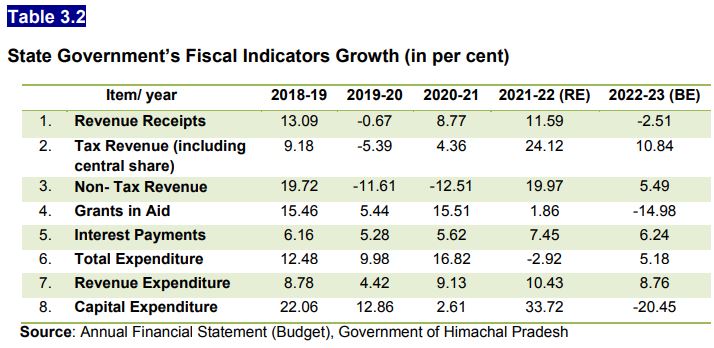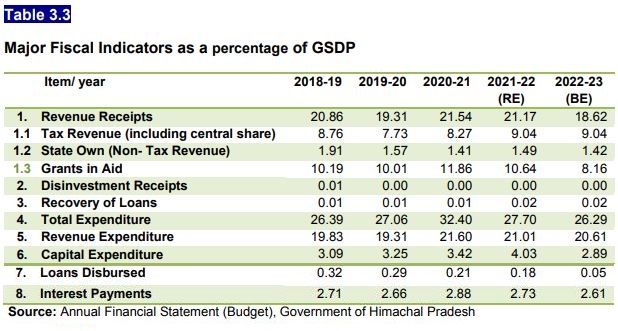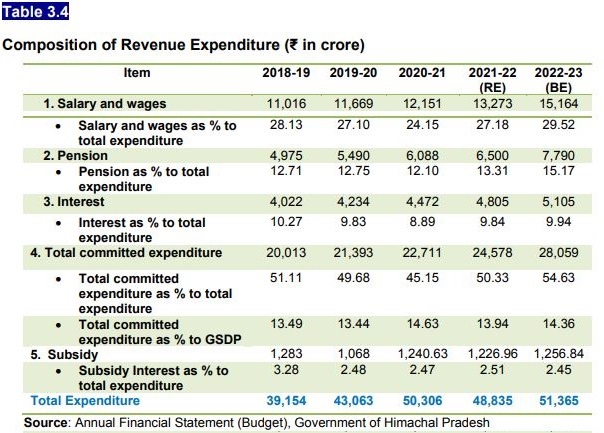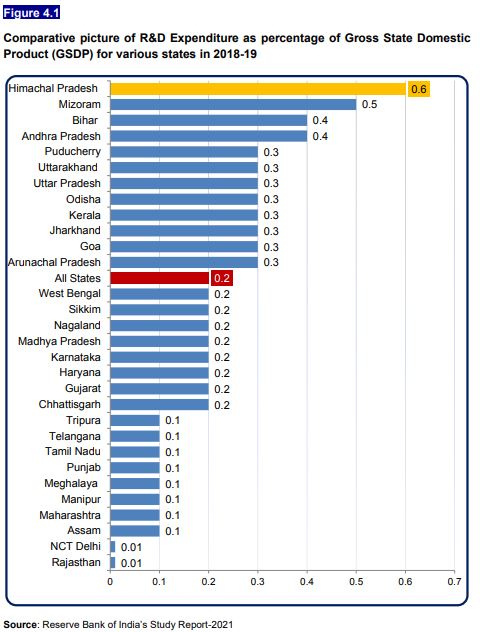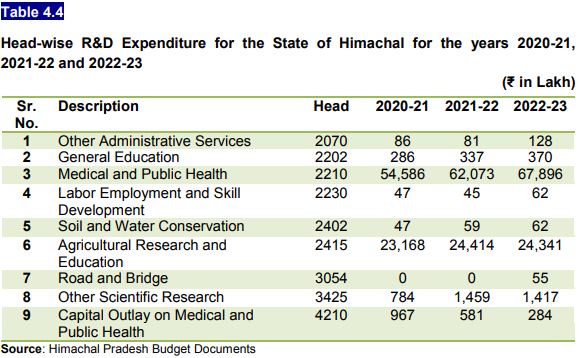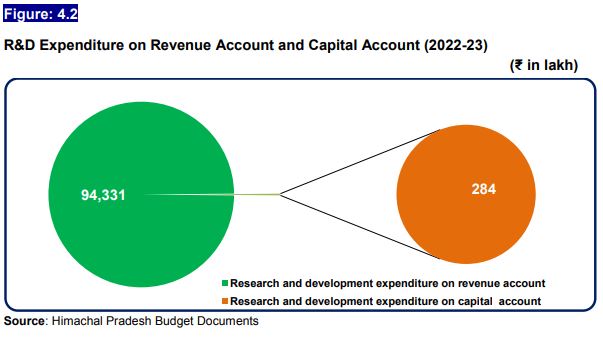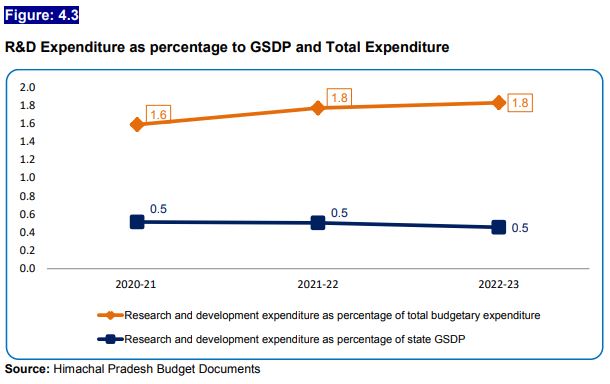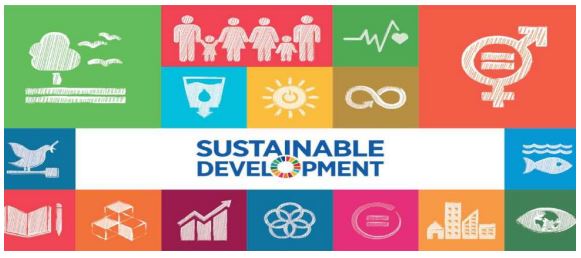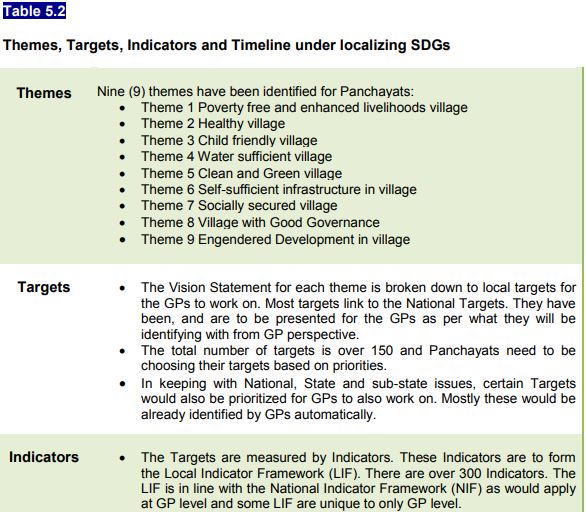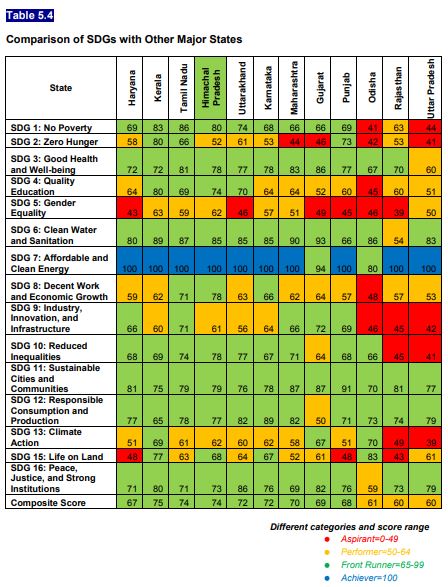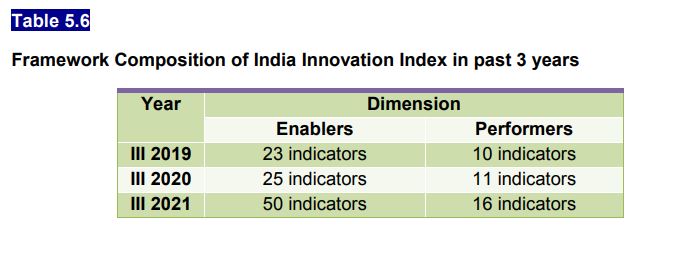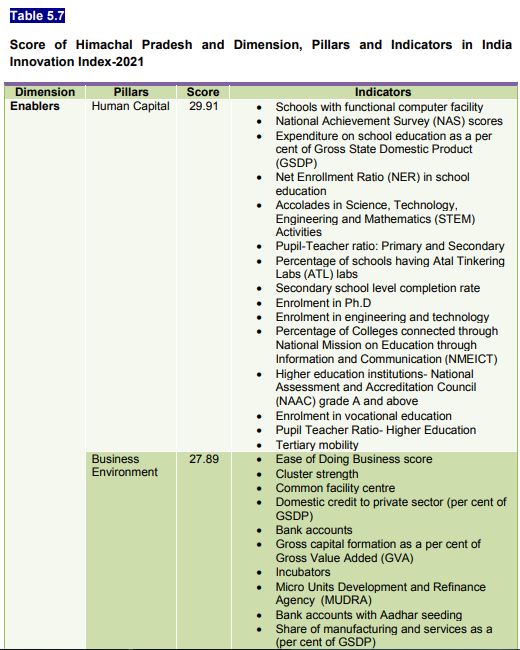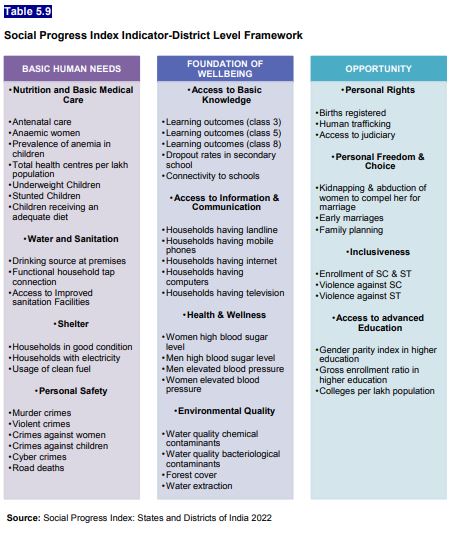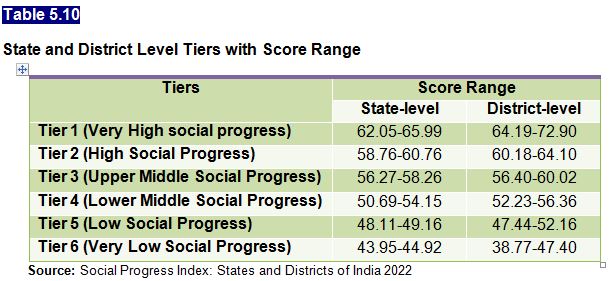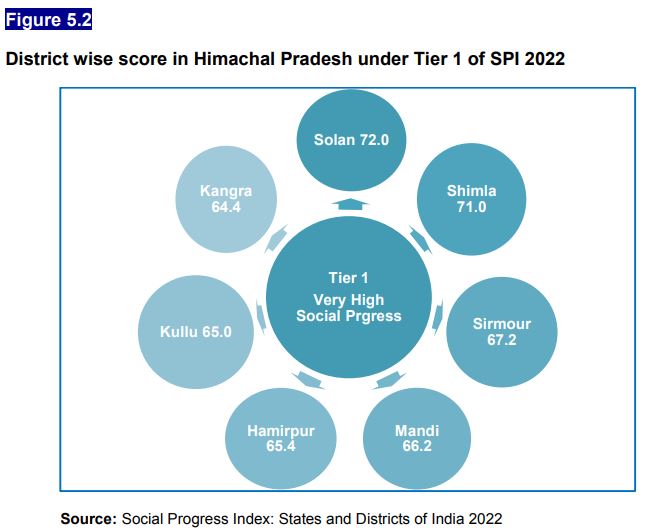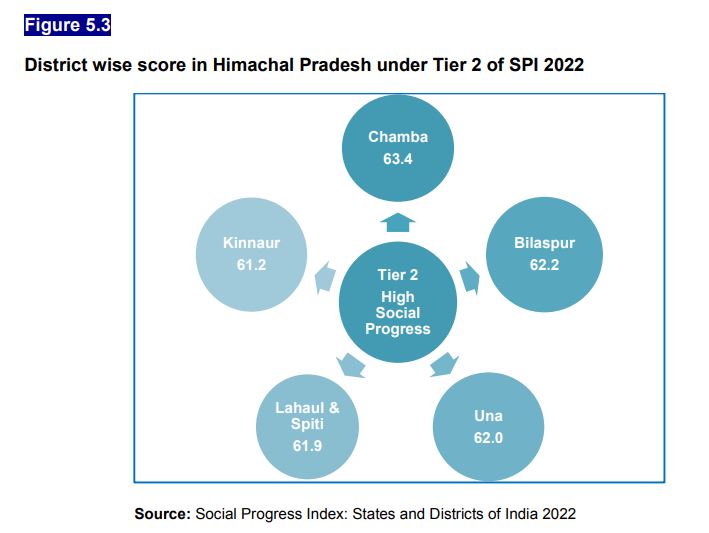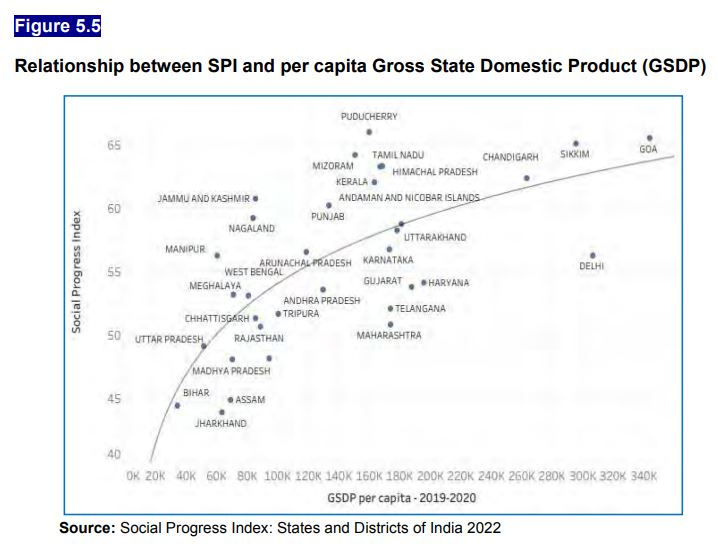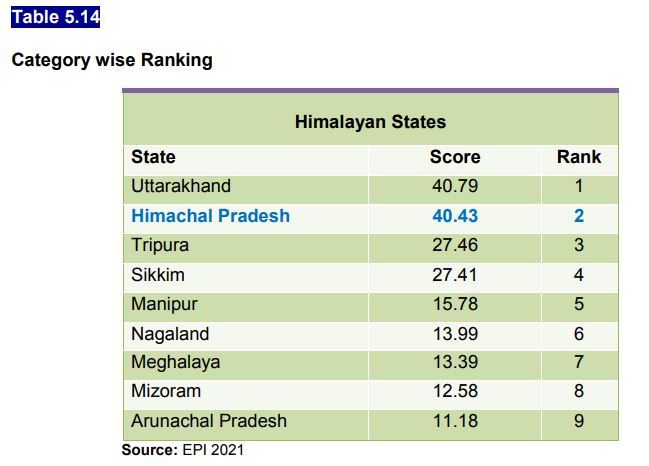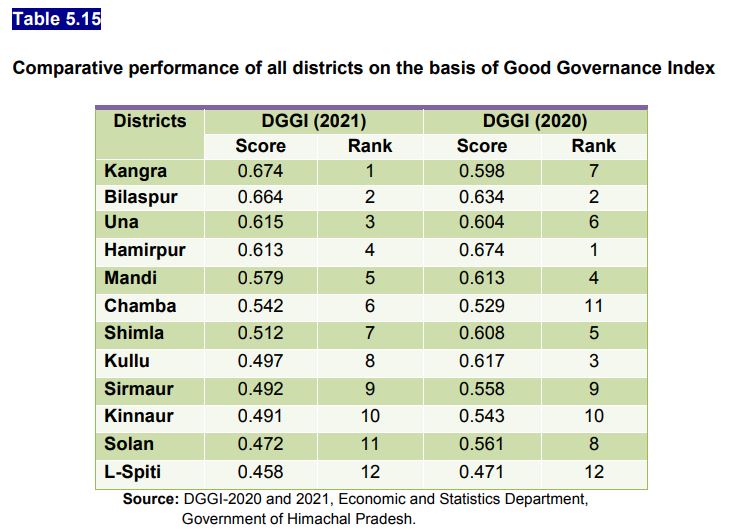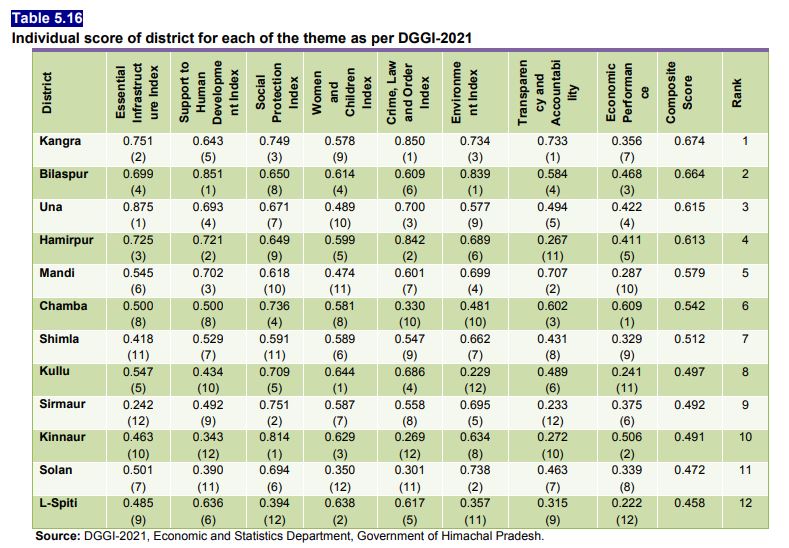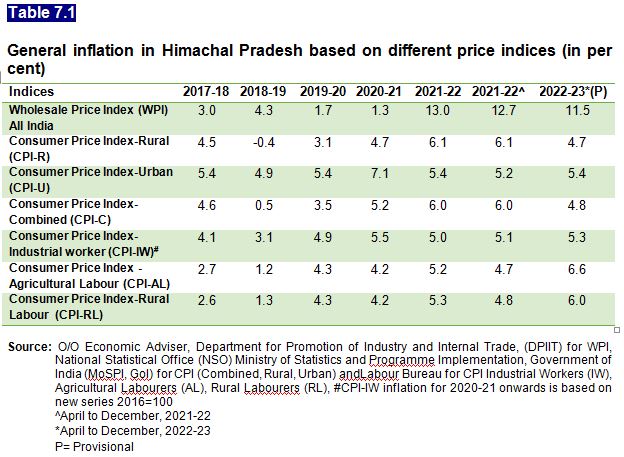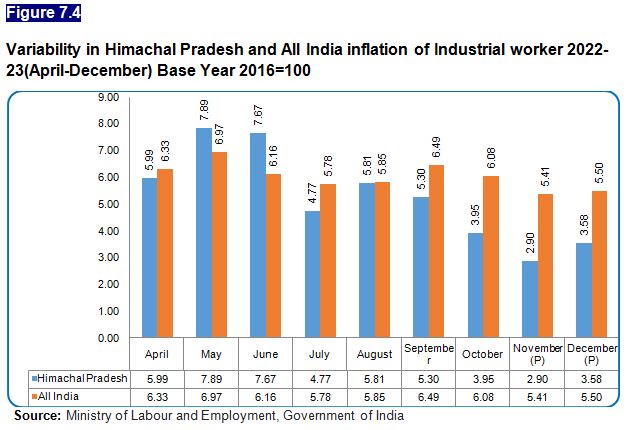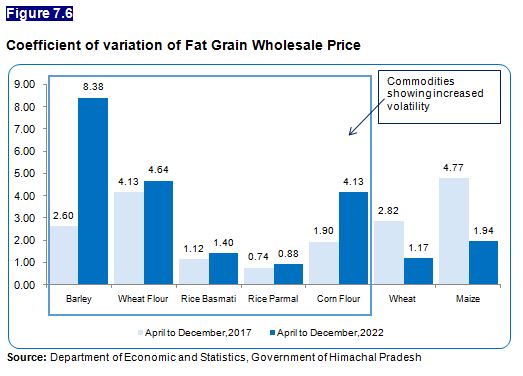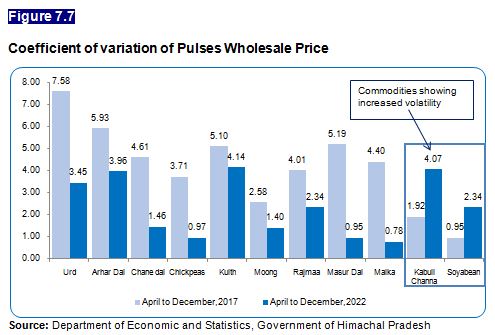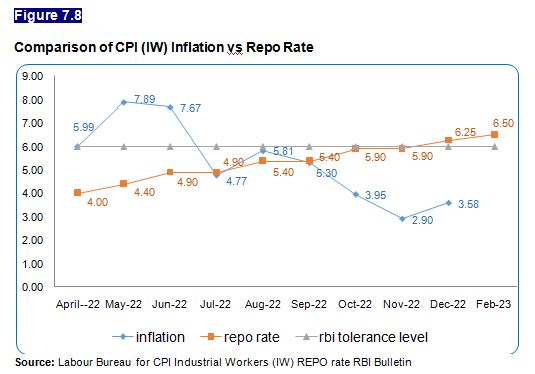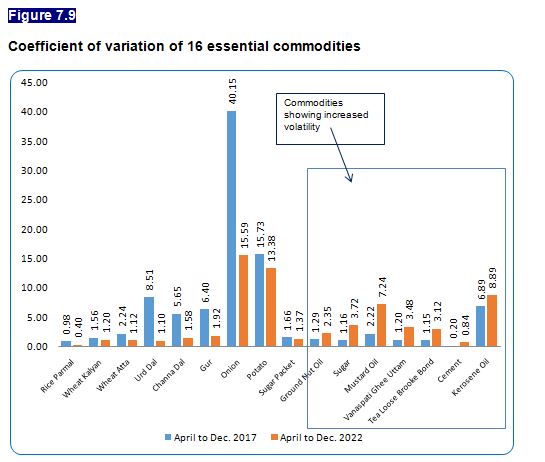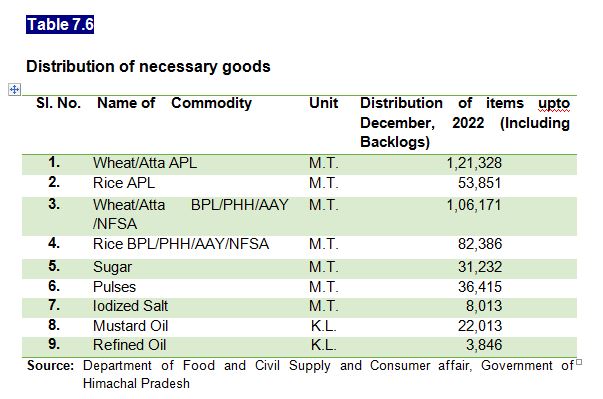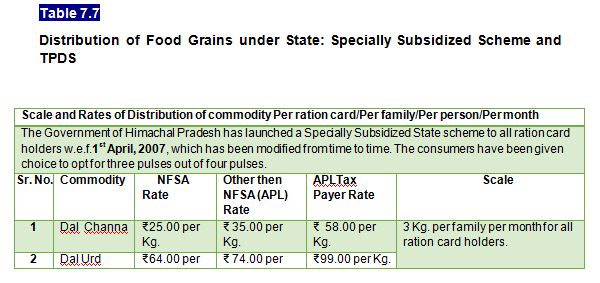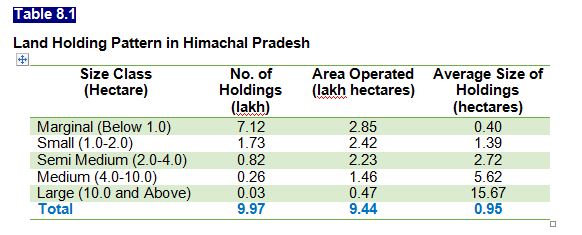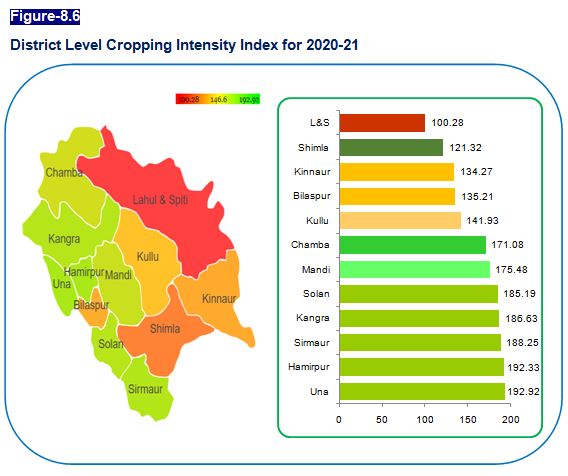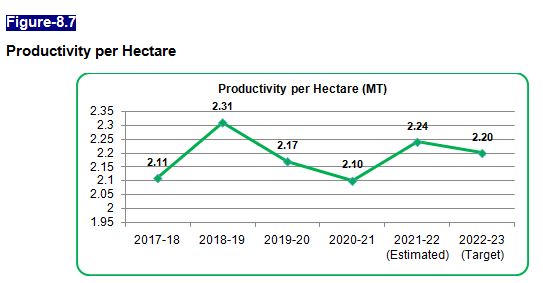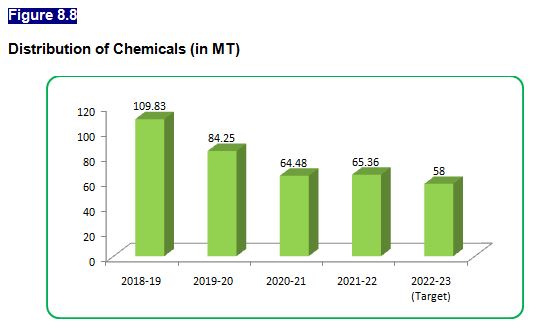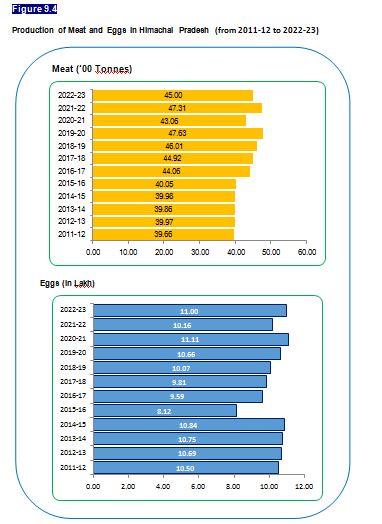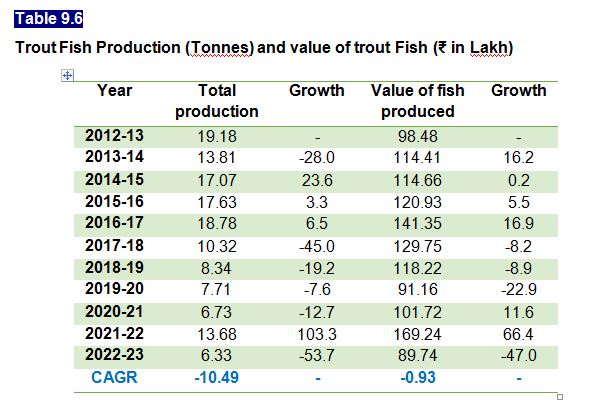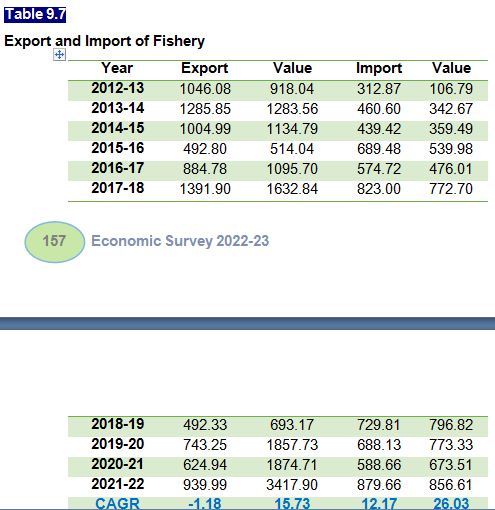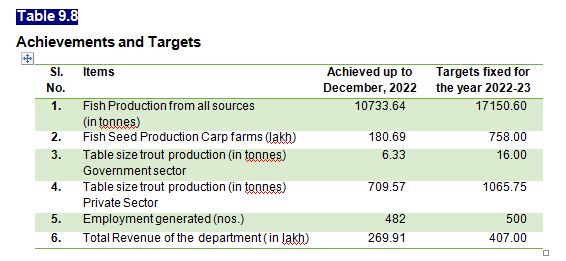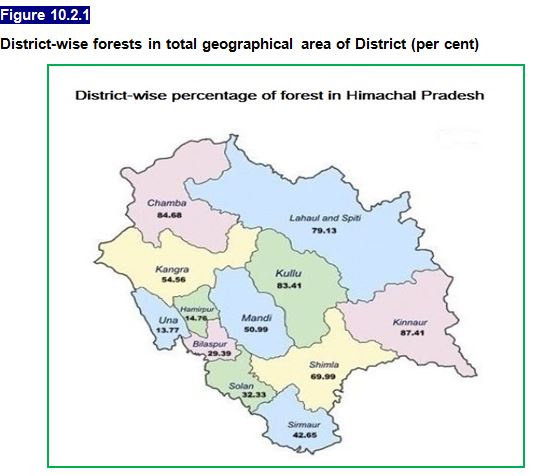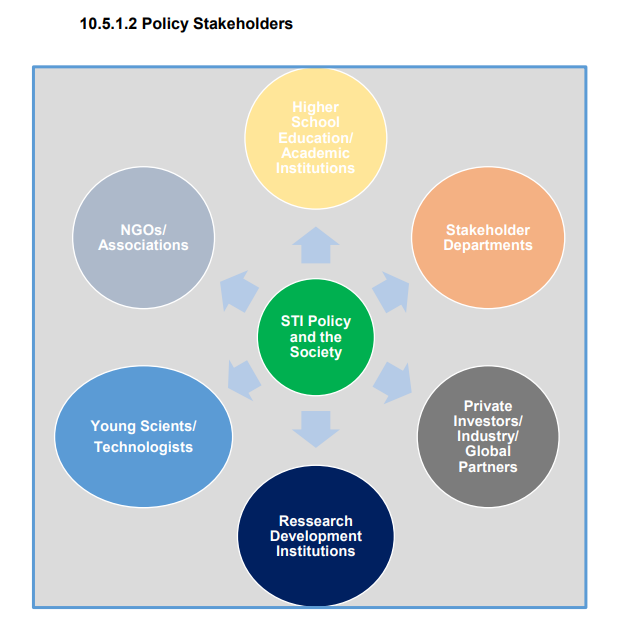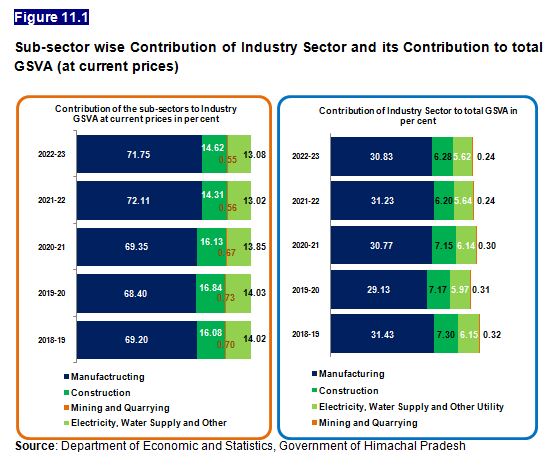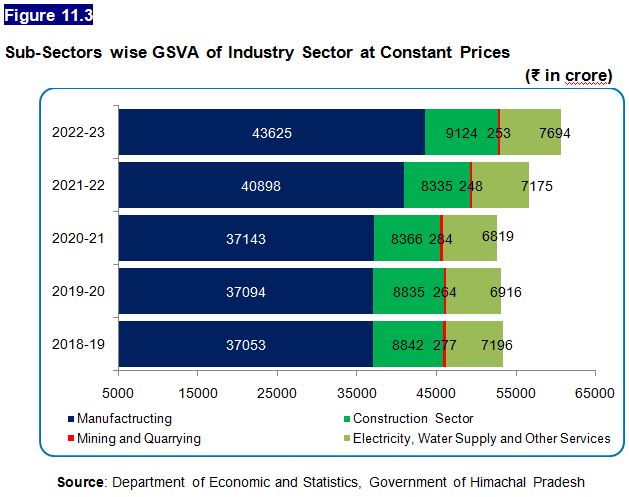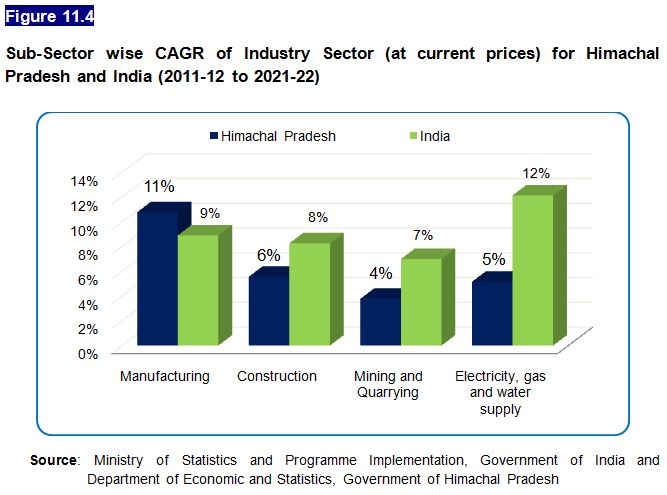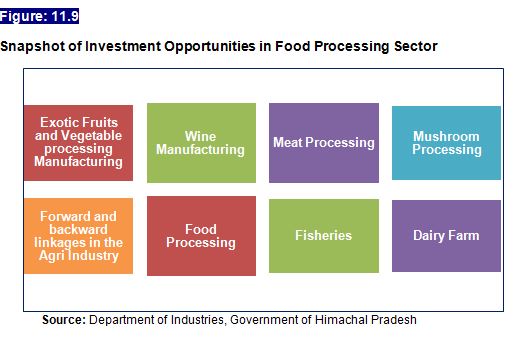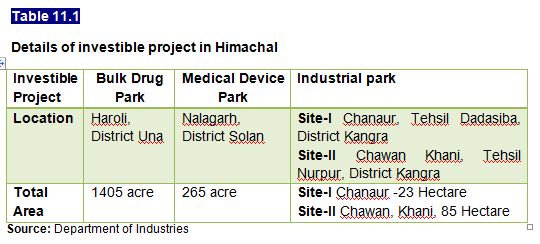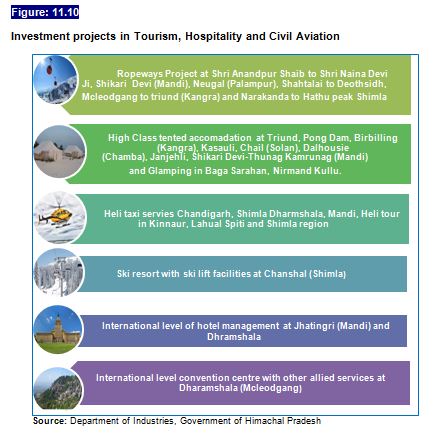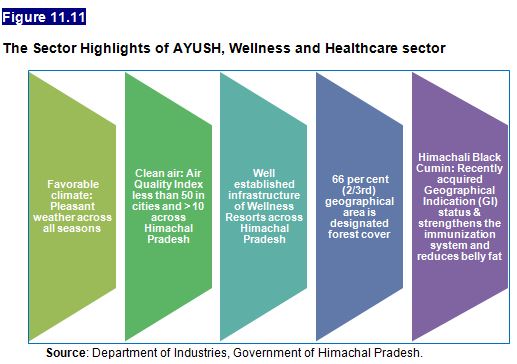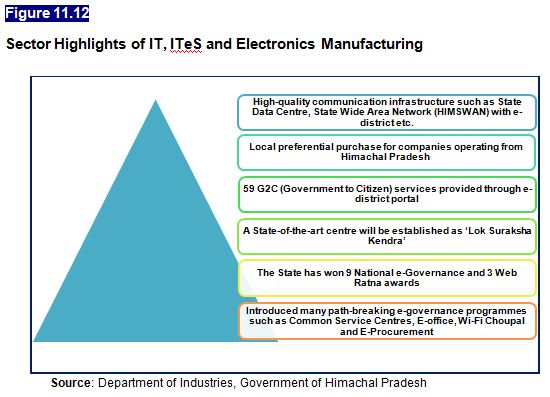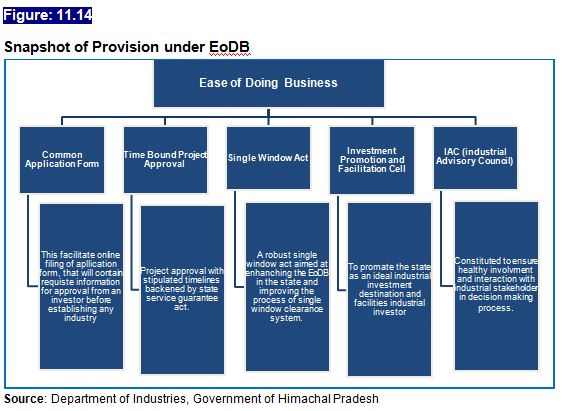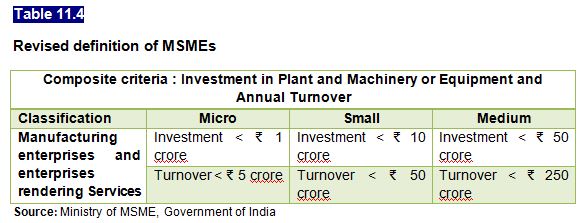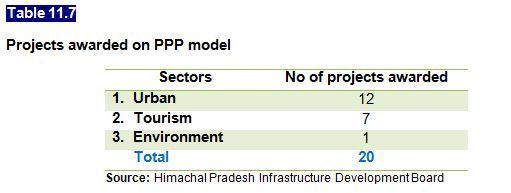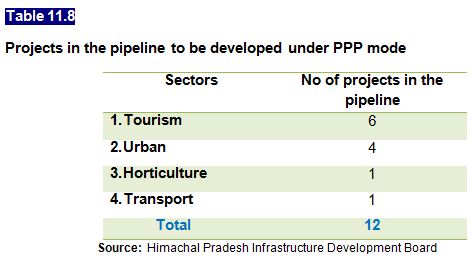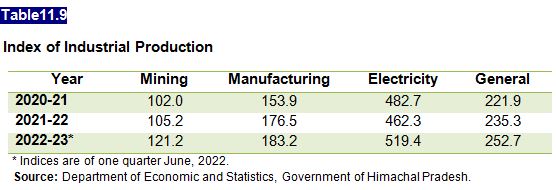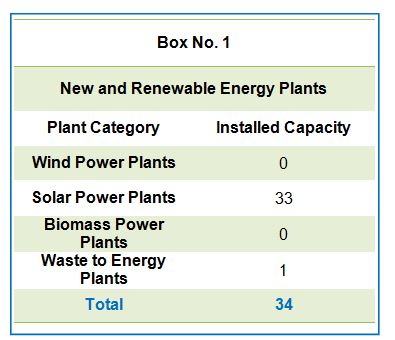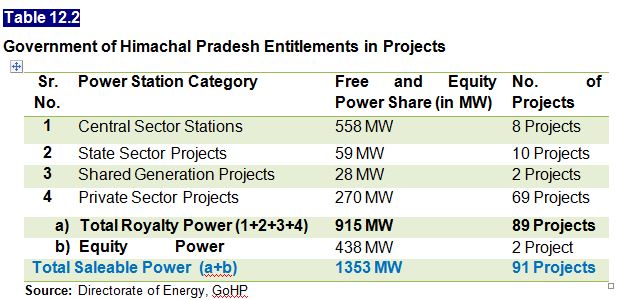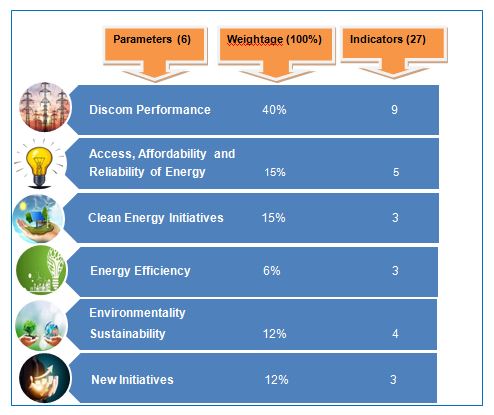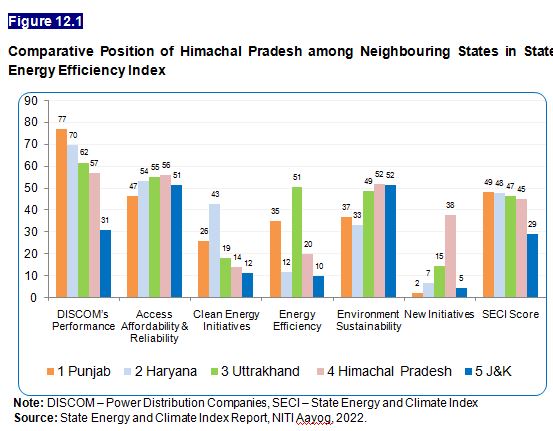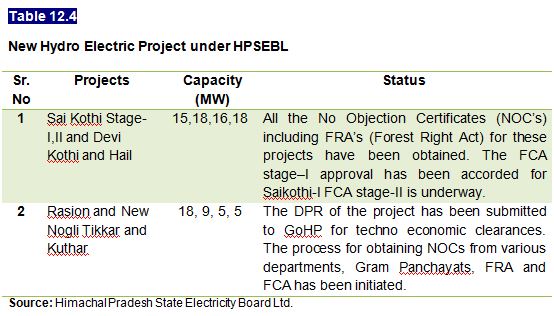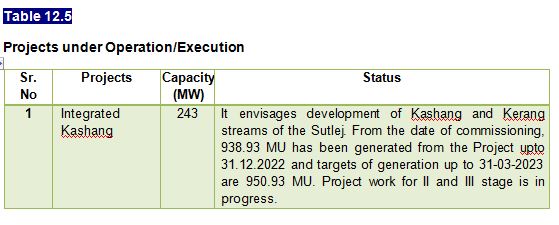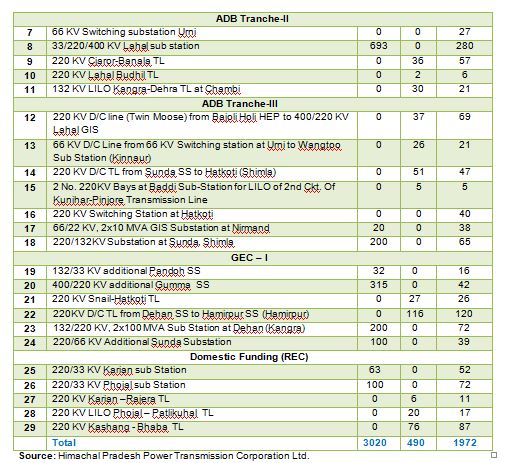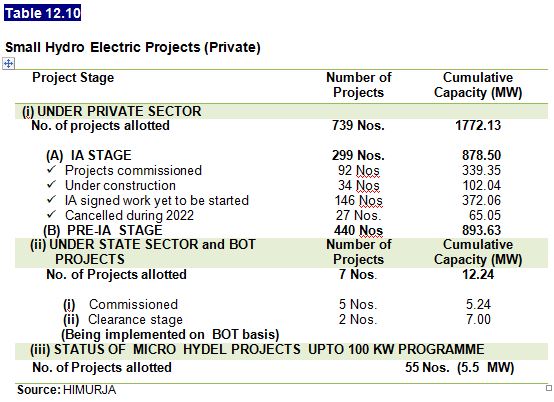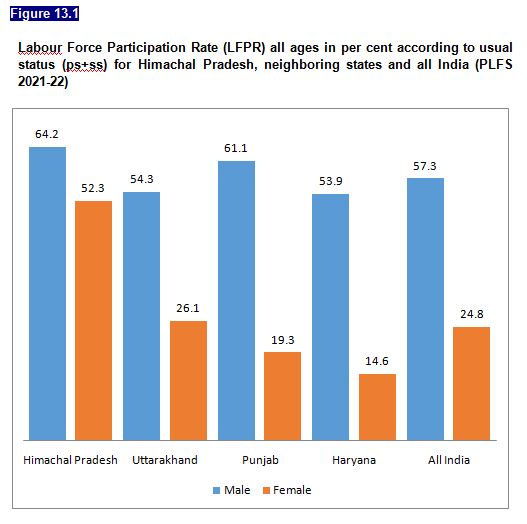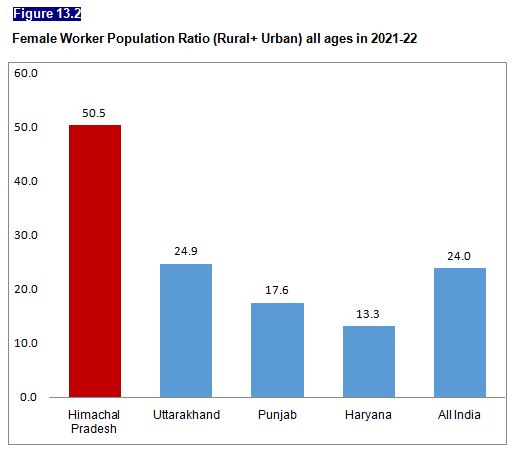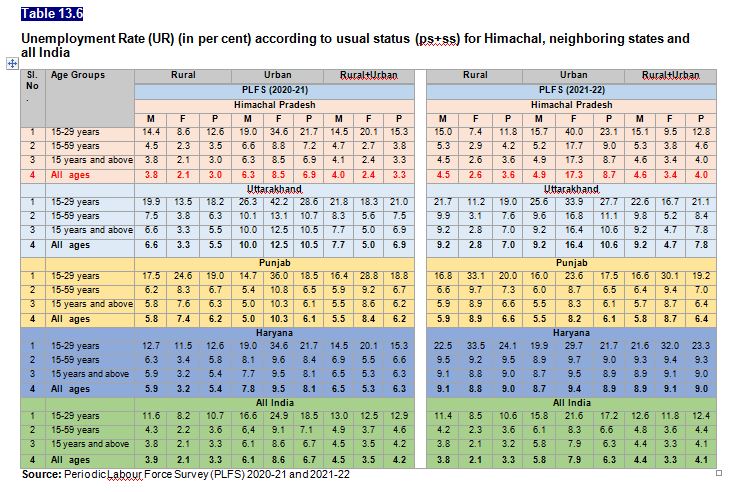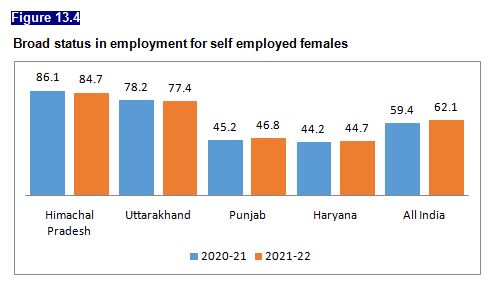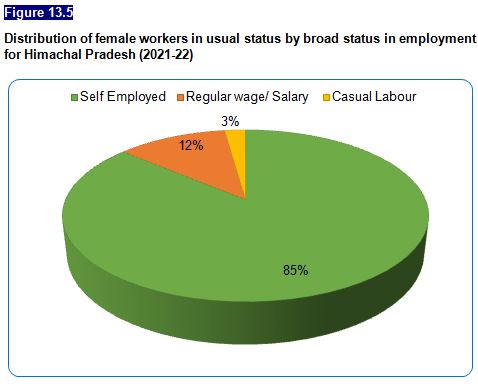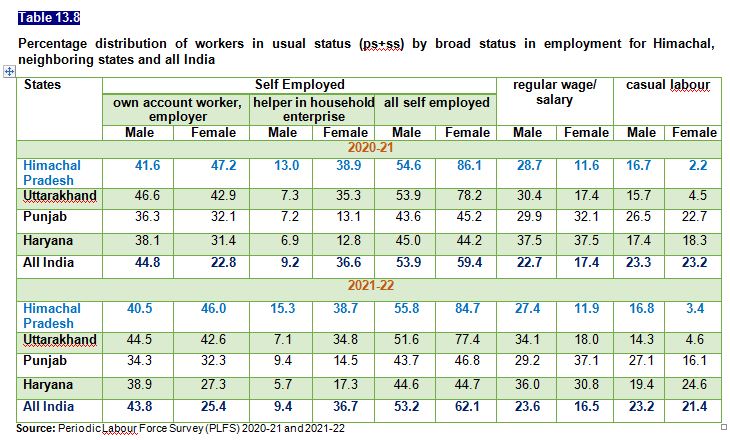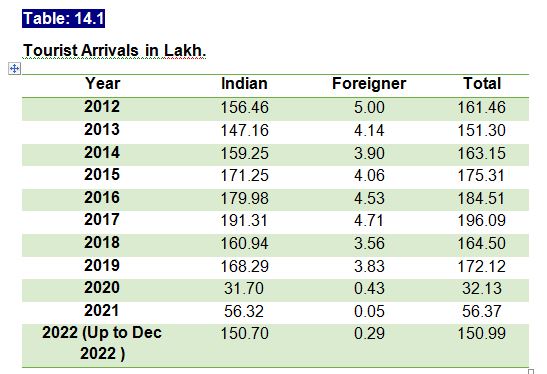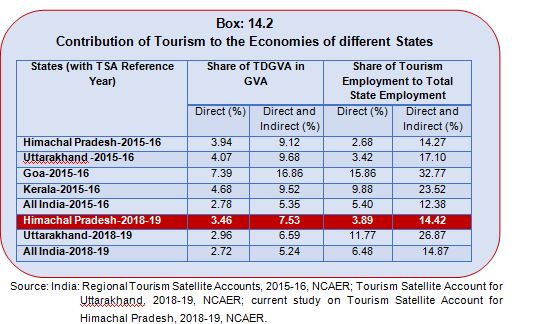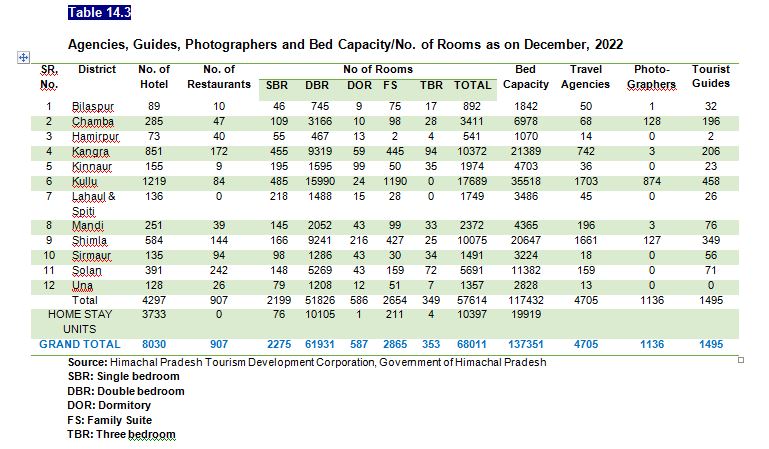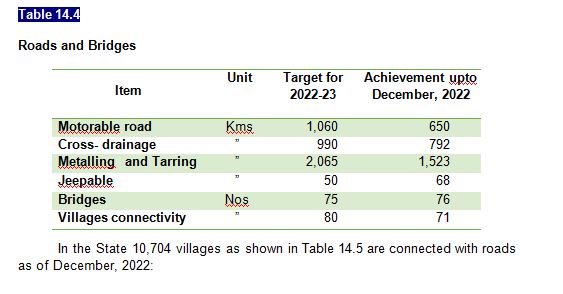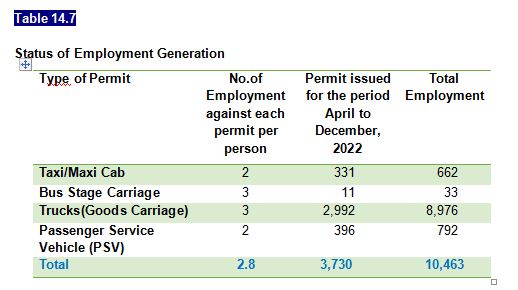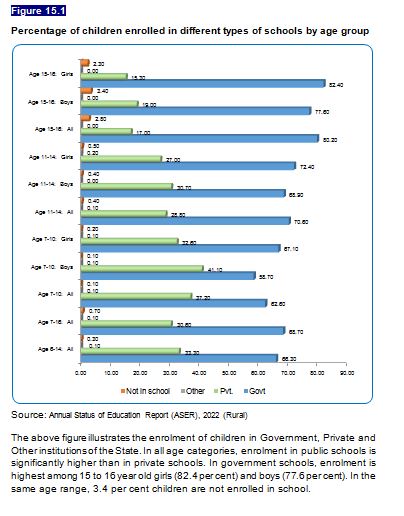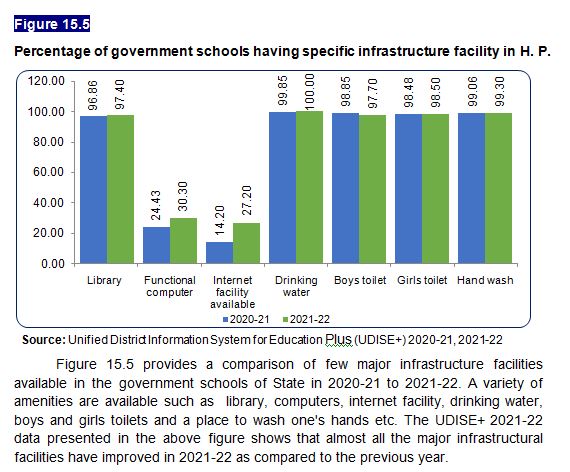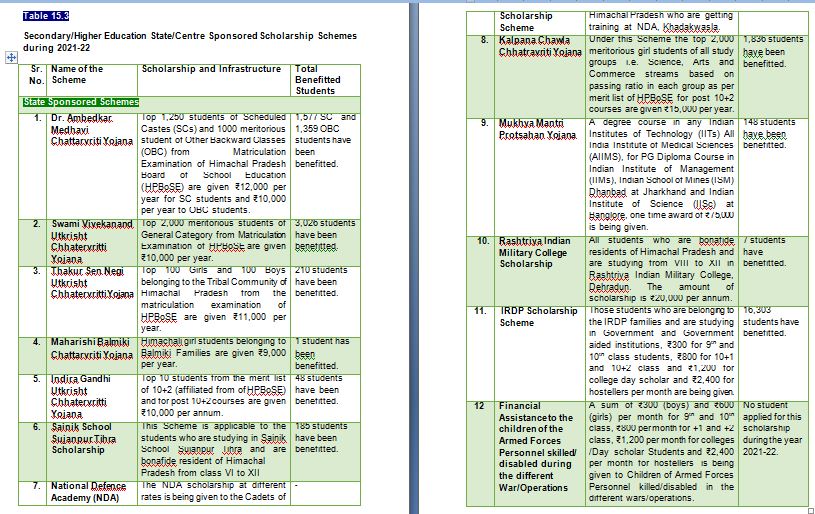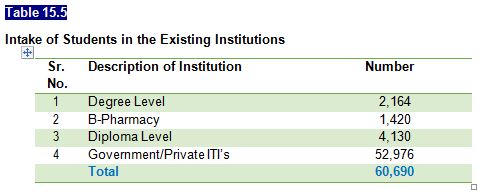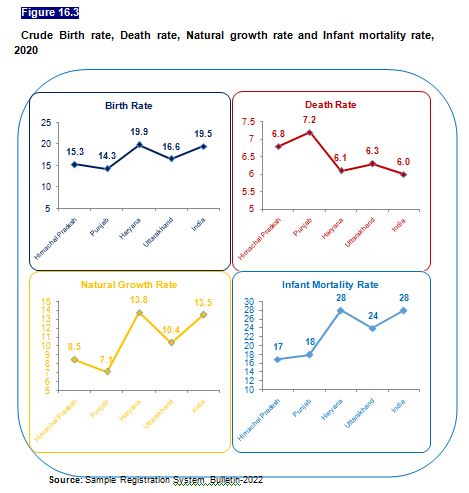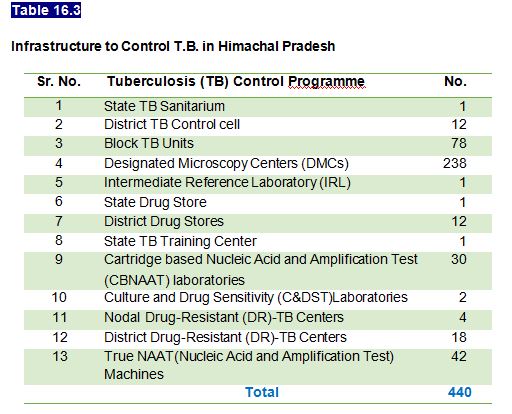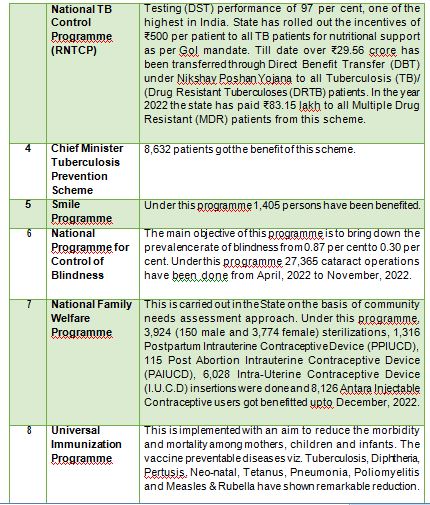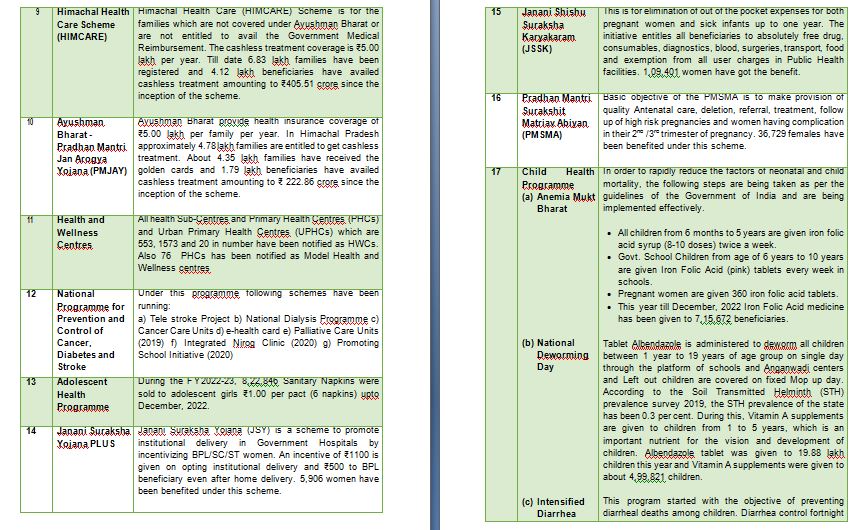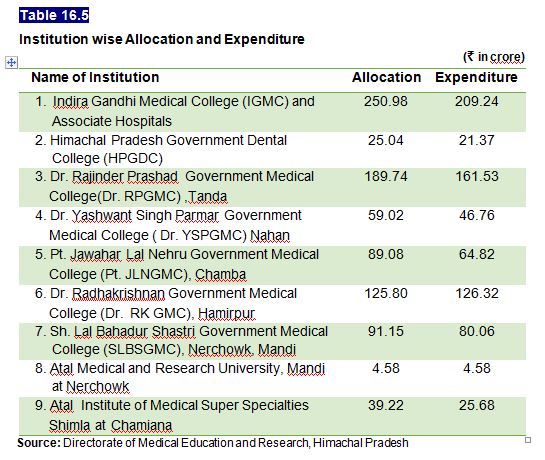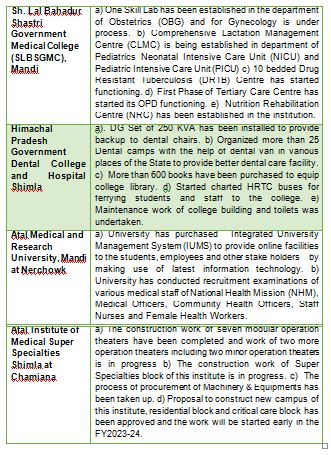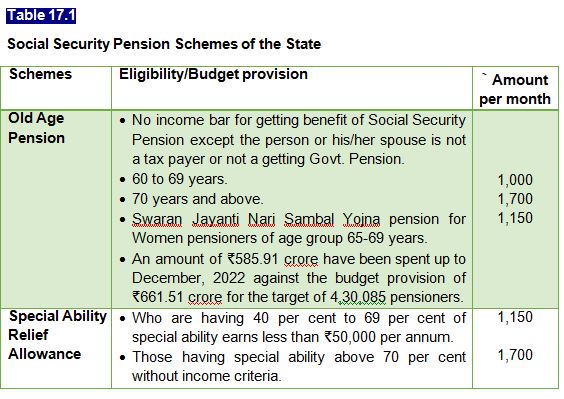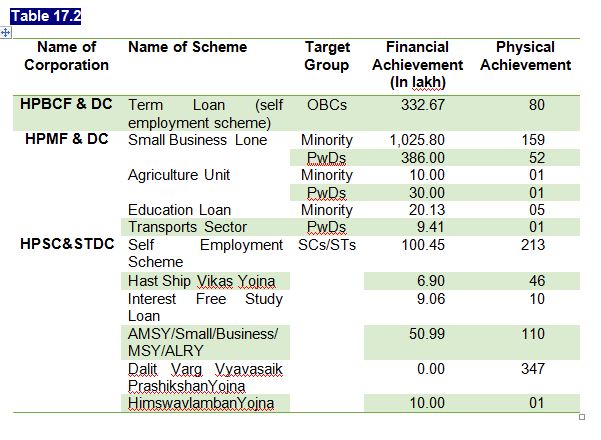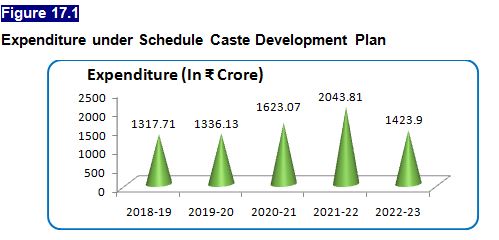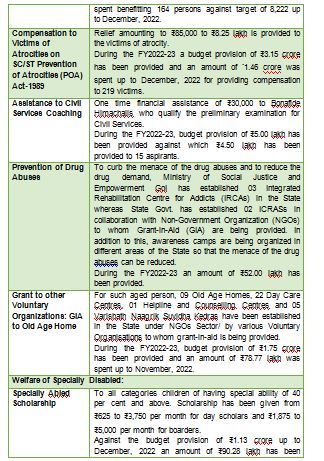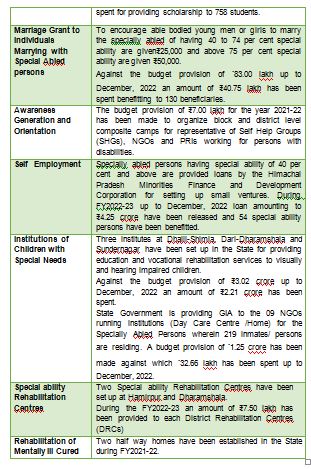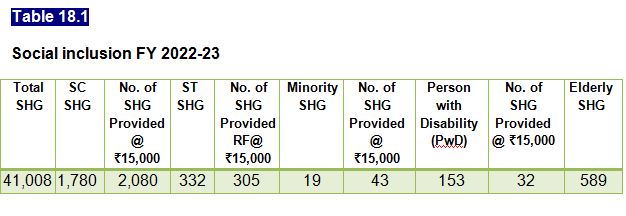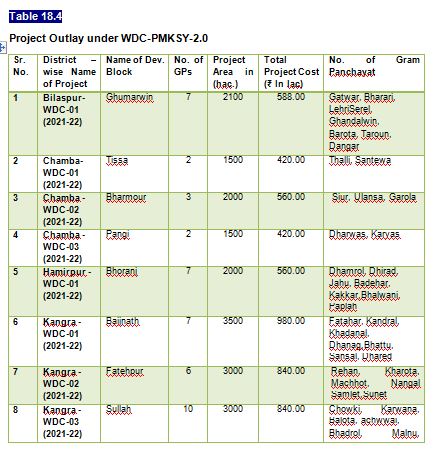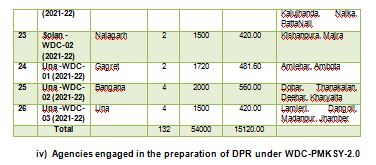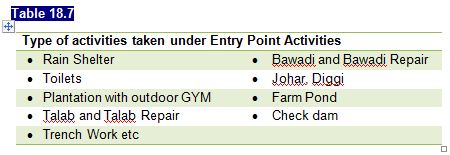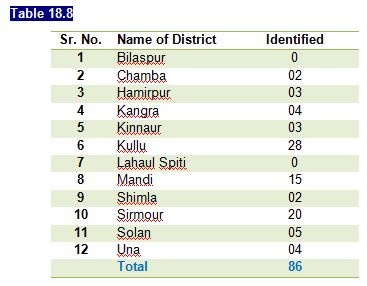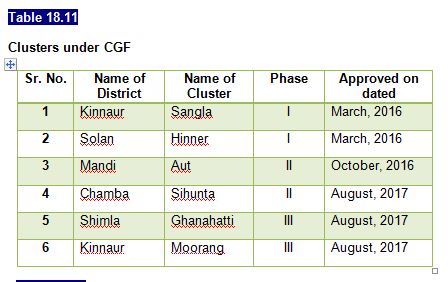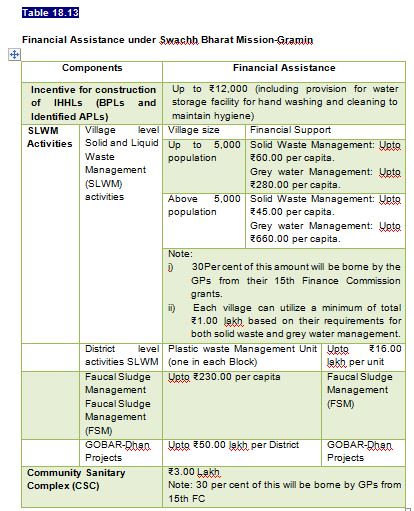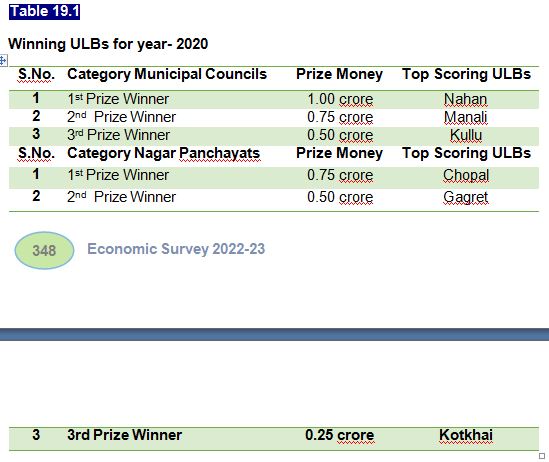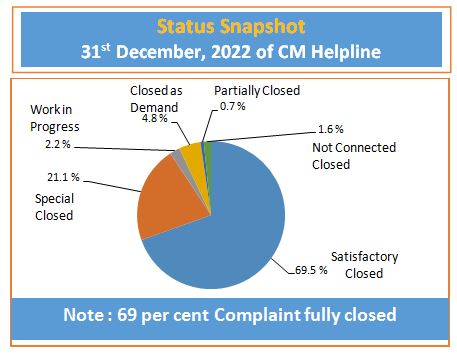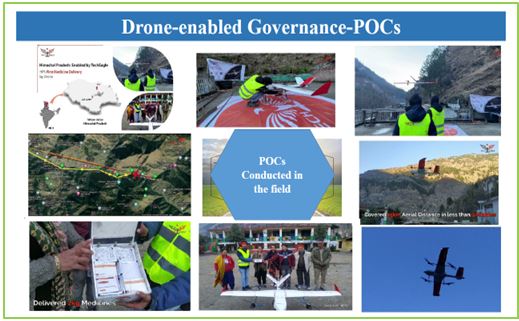State Sponsored Schemes
Mukhyamantri Krishi Samvardhan Yojna (MMKSY): According to the Expert Group's recommendation, eight ongoing programmes with similar goals have been consolidated
in FY2022–23 to prevent activity duplication. The following are the scheme's components:
1) Cluster based vegetable production scheme.
2) Input based umbrella scheme (Seed, Parts Per Million (PPM) & Fertilizers).
3) Strengthening of Seed Multiplication Chain.
4) Strengthening of laboratories.
Under this scheme, a budget provision of ₹11.23 crore has been made for FY2022-23
i) Cluster Based Vegetable Production Scheme:
Vegetables in general and green leafy vegetables in particular provide essential minerals, vitamins, and thus are a vital part of the human
diet and nutritional security, thereby contributing to the achievement of SDG 2: End hunger, ensure food security, improve nutrition, and promote
sustainable agriculture. Recent technical advancements in agriculture have highlighted the need for diversification, indicating that vegetables are
expected to provide farmers and the state with great potential for quick economic growth. The Department has planned to gradually use the "Cluster Approach"
for vegetable growing over the whole state. This strategy aims to boost the development of economically competitive vegetable crops and increase the income of farmers.
ii) Input Based Umbrella Scheme (Seed, Plant Protection Material & Fertilizer):
Under eight State sector programmes, the Department of Agriculture provided subsidies for various agricultural inputs.
The unified scheme, known as the "Mukhya Mantri Krishi Samvardhan Yojna," would cover all agricultural inputs, including seeds, fertilisers,
plant protection material, assistance for high-yielding varieties of high-value crops, and incentives for value addition and branding of indigenous maize varieties.
iii) Strengthening of Seed Multiplication Chain:
Seed multiplication is an essential agricultural activity and a crucial element of the seed chain for achieving self-sufficiency in seed, a resource for which
we are mostly dependent on neighbouring states. Since seed multiplication is a continual scientific process including the generation of Nucleus Seed, Breeder Seed,
Foundation Seed, and Certified Seed, these four types of seeds must be produced. Government farms play a crucial role in the multiplication of quality seed in the
state and in reducing reliance on adjacent state agencies. Currently, 36 Departmental Farms cultivate various crops, including Paddy, Mash, Soybean, Wheat, Seed Potato,
Rajmash, etc. On these farms, around 17,000 quintals of Foundation Seed of various crops are generated annually, which is then replicated as certified seed by the progressive farmers
of the state.
Strengthening of Laboratories (Fertiliser Testing, Soil Testing, Bio-control, Seed Testing, Bio-fertiliser and State Pesticide Testing Laboratory).
iv) Strengthening of Laboratories: (Fertiliser Testing, Soil Testing, Bio-control, Seed Testing, Bio-fertiliser and State Pesticide Testing Laboratory):
There are 11 Soil Testing Laboratories, 3 Fertilizer Testing Laboratories, 2 Bio-Control Laboratories and 1 each State Pesticide Testing Laboratory and Bio-Fertilizer Production
and Quality Control Laboratory in the State. All of these are run by the Department of Agriculture. Farmers can get free soil tests from the Department of Agriculture to find out
how healthy their soil is. Besides this, the state has quality control labs for seed, fertiliser, and pesticide so that farmers can get high-quality inputs. Two bio control labs
are also working in the districts of Kangra and Mandi to promote non-chemical ways to get rid of insect pests. These labs show farmers how to use bio agents, bio-pesticides, traps,
lures, etc. for free on their fields.
Mukhya Mantri Krishi Utpadan Sanrakshan Yojana (MMKUSY): The three protection-based Departmental schemes that were already in place and had the same goal were combined into a single scheme called "Mukhya Mantri Krishi Upadan Sanrakshan Yojana," which has three parts.
1) Sour Badhbandi (Solar Fencing)
2) Anti Hail-Net Structure
3) Green House Renovation Scheme
Under this scheme, a budget provision of ₹51.00 crore has been made for FY2022-23
i) Solar Fencing
a) Every year in the State, crops lose a lot of money because of monkeys and other wild animals. The current practice of manually guarding crops does not guarantee that all of the crops will be safe. So, in 2016-17, the Government of Himachal Pradesh started a programme called "MMKUSY."
b) Under this plan, a subsidy of 85 per cent is granted if three or more farmers want to build solar fence, and an 80 per cent subsidy is provided if a farmer chooses to install solar fencing on individual property. The electric fence is powered by solar panels. The current in the fence encircling the farms will be enough to keep stray animals, wild animals, and monkeys away from the crops. The Himachal Pradesh Government has also authorised the erection of barbed and chain link fence, as well as composite fencing, for 2019-20.
ii) Anti Hail-Nets
The State Government is implementing the "Krishi Utpadan Sanrakshan Yojana (Anti Hail Net Structure) Scheme" to protect crops from hailstorms.
The plan is known as "MMKUSY" and is known as Anti Hail Nets. The plan will benefits farmers by assisting them in significantly reducing quantitative
and qualitative losses. Eligible farmers can get up to 80 per cent financial help for the procurement of anti-hail nets.
iii) Green House Renovation Scheme
Farmers in the State had urged that a plan be developed to replace the Poly sheets. As a result, the Himachal Pradesh government launched the "Mukhya Mantri Green House Renovation Scheme"
in 2017-18. The project has now been combined as a component of the Scheme "Mukhyamantri Krishi Utpadan Sanrakshan Yojana," meaning Green House Renovation. This component provides farmers
with 70 per cent support for the replacement of poly sheet after 5 years of setting up the polyhouse or damage due to natural catastrophes.
Himachal Pradesh Crop Diversification Promotion Project (HPCDP)(Japan International Cooperation Agency (JICA) –External Aided Project (EAP):
Phase –I
To promote sustainable agricultural diversification in prospective locations, the crop promotion diversification project of ₹321.00 crore assistance from JICA was sanctioned and implemented
in the State till 2020. The project's objectives were to increase the area and production of vegetables through crop diversification, to increase the income of small and marginal farmers,
to build infrastructure for irrigation, farm access roads, marketing, and post-harvest, to organise farmers into groups to take over irrigation system operation and maintenance, and to train
and capacitate Department of Agriculture field extension staff. Himachal Pradesh Agriculture Development Society carried out the project. This project included the construction of 210 small
irrigation schemes, 29.40 KM connection road, and 23 collecting centres. Kangra, Mandi, Una, Bilaspur and Hamirpur were selected as project locations.
Phase –II
The Phase-II JICA-Official Development Assistance (ODA) project, with an outlay of ₹1010.13 crore, is being implemented in all districts of the state during
the following nine years. On 26th March, 2021, the Government of India and JICA signed a MoU for the implementation of the second phase. During the FY2021-22,
a total of ₹20.00 crore was spent. HPCDP has been allotted ₹20.00 crore for FY2022-23.
Mukhya Mantri Nutan Polyhouse Pariyojana: Protected cultivation is critical for enhancing the yield / productivity of various cash / high value crops such as vegetables. With the necessity of protected cultivation in mind, the Government of Himachal Pradesh has proposed a new plan, Mukhyamantri Nutan Polyhouse Pariyojana, totaling ₹150.00 crore and spanning around 100 hectares in the state. This programme will result in the construction of 5000 ployhouses. This plan will be implemented in two stages.
The first phase, which will cost ₹78.57 crore, will run from FYs 2020–21 to 2022–23, and 2,522 polyhouses will be built. For the construction of polyhouses for approved models, this initiative provides for 85 per cent subsidy support. Amount of ₹22.00 crore has been allocated for this project for FY2022–2023.
Mukhyamantri Kisaan Evam Khetihar Mazdoor Jeevan Suraksha Yojana: The State Government has introduced a Program named "Mukhyamantri Kisaan
Evam Khetihar Mazdoor Jeevan Surakhsha" in 2015–16 with the goal of providing insurance coverage to Farmers and Agricultural Labourers in the event of
suffering injury or death due to operation of farm machinery. The affected farmers are given compensation in the event of a partial amputation, permanent
handicap, or death in the amount of ₹10,000 to ₹40,000, ₹1.00 lakh, and ₹3.00 lakh, respectively.
Agriculture Marketing: Himachal Pradesh Agricultural and Horticultural Produce Marketing Development and Regulation Act, 2005" governs agricultural
marketing. Himachal Pradesh State Agricultural Marketing Board (HPSAMB) and 10 District Agriculture Produce Marketing Committees (APMCs) are formed to market
agricultural products in the state. Growers are served by 71 market yards (10 APMC and 61 sub Market Yards). These markets sell fresh produce and grains.
www.agmarknet.gov.in periodically posts marketing data, including commodity prices, for stakeholders. All India Radio, Doordarshan and Newspapers report
prices. In expanding areas, farmer's awareness camps teach marketing's latest techniques. Government grants are used for many tasks, including market yard
building. Electronic-National Agriculture Market connects 26 state wholesale marketplaces (e-NAM).
Prakritik Kheti Khushal Kisan Yojana under Zero Budget Natural Farming(PKKKY-ZBNF): The State Government has introduced the "PKKKY" initiative to
promote "ZBNF" in order to reduce cultivation costs. The use of synthetic fertilisers and pesticides is discouraged. The funds allocated to the Department of
Agriculture and Horticulture for pesticides/insecticides are utilised to deliver bio-pesticides and bio-insecticides. Till date 1,71,063 farmers in the state
have opted natural farming, spanning an area of 9464 hectares. Natural farming covered 54,237 farmers in the FY2021-22. An extra 20,000 hectares will be covered
in FY2022-23. For FY2022-23, a budget provision of ₹17.00 crore has been made.
Jal Se Krishi Ko Bal Yojana: The project "Jal Se Krishi Ko Bal” has been started to provide water for irrigation. Check dams and ponds are built
as part of this programme. Farmers can utilise this water for irrigation after building separate small lifting schemes or flow irrigation schemes. The Government
bears the whole cost of implementing a community-based modest water-saving system under this scheme. For FY2022-23, a budget provision of ₹25.00 crore has been made.
Flow Irrigation Scheme: Under this scheme, besides renovating the source location of Kuhls, strengthening of kuhls in common area is undertaken. Under this scheme,
100 per cent expenditure is borne by the Government on community based work. Government has decided to grant 50 per cent subsidy for construction of bore-wells and shallow wells
by individual for irrigation purposes under this scheme. A budget provision of ₹15.00 crore has been kept for FY2022-23.
Rajya Krishi Yantrikaran Karykram: Farm mechanisation involves the introduction of newly designed equipment and advanced technology to the state's farmers.
The Department ensures that farmers have access to subsidised tools and machinery. This year, the state government is offering a 40 per cent to 50 per cent subsidy
on additional equipment such as chaff cutters, maize shellers, wheat thrashers, sprayers, brush cutters, toolkits, stainless steel ploughs, mould board ploughs,
seed bins, water tubs, and so on. The State Government has set aside ₹17.50 crore for FY2022-23.
Mukhya Mantri Krishi Kosh Yojana (MMKKY): Farmers Producer Organizations with little resources and difficulty constructing infrastructural facilities
on their own. They represent farmers, horticulturists, dairy farmers, and fishers. They require fundamental inputs during planting, harvesting, and post-harvest
infrastructure such as grading and packing machinery, transport vehicles, storage godowns, and pack houses, among other things, which demand long-term investments.
The State Government has started Krishi Kosh, to assist farmers with seed money, interest subsidies, and credit guarantee coverage. For FY2022-23, a budget provision of ₹5.00 crore has been kept.
Krishi Se Sampannta Yojana (KSY): The Institute of Himalayan Bio Technology (IHBT) Palampur has found a novel type of Heeng (Asafoetida) that can be cultivated in high altitude areas
like as Lahaul and Spiti, Kinnaur, and Chamba, among others. Similarly, climate conditions for saffron growth are particularly good in various sections of the state. With the importance and ideal
growing circumstances of both crops in mind, the Krishi Se Sampannta Yojana is being implemented in the state. For FY2022-23, a budget provision of ₹3.00 crore has been established.
Centrally Sponsored Schemes
Rashtriya Krishi Vikas Yojana (RKVY RAFTAAR): Rashtriya Krishi Vikas Yojana is helping the state expand agriculture and allied sectors. The scheme's main goals are to
incentivize states to increase public investment in agriculture and allied sectors; provide flexibility and autonomy to states in planning and executing agriculture and allied sector schemes;
ensure the preparation of agriculture plans for districts and states based on agro-climatic conditions, technology, and natural resources; and ensure that local needs/crops/priorities are met.
Along with universities, the Department of Agriculture, HPSAMB, and the Department of Industries and Horticulture are also involved in the implementation of this scheme.
Under this scheme, a budget allocation of ₹27.70 crore has been approved for FY2022-23.
National Bamboo Mission: The Cabinet Committee for Economic Affairs gave its approval to the reorganised National Bamboo Mission on 25th April, 2018. The main goal of
this mission is to increase the area under bamboo plantation on non-forest Government and private lands to supplement farm income, contribute to climate change resilience, and make
quality raw materials available for industries. It also aims to improve post-harvest management through the establishment of innovative primary processing units close to the source
of production, promote skill development, capacity building, and awareness generation for farmers. The Director of Agriculture, Himachal Pradesh, has been designated as the State
Mission Director, and the Department of Agriculture, Himachal Pradesh, as the Anchoring Department. Departments of Forestry, Rural Development, Panchayati Raj, Industries,
and State Agricultural Universities are among the stakeholders.
Crop Insurance Scheme: From the Kharif 2016 growing season onward, the Pradhan Mantri Fasal Bima Yojana (PMFBY) and "Restructured Weather Based Crop Insurance Scheme
(R-WBCIS)" are in effect in Himachal Pradesh. Wheat and barley crops are covered during the Rabi season under PMFBY, while maize and paddy crops are covered during the Kharif season. This new programme covers the many phases of agricultural loss risks caused by preventive planting, post-harvest losses, localised catastrophes, and losses to standing crops (from sowing to harvest). The scheme is voluntary for both loaned and unloaned farmers as of Kharif 2020. In accordance with PMFBY, Center and State will split payments equally for claims that total more than 350 per cent of the premiums collected or more than 35 per cent of the total amount insured at the national level, whichever is larger. Six crops, including potatoes, ginger, tomatoes, peas, cabbage, and cauliflower, are covered under the Restructured Weather Based Crop Insurance Scheme (R-WBCIS) during the Kharif season and potatoes, tomatoes, garlic, and capsicum during the Rabi season. The program's goal is to give producers insurance protection against meteorological events including rain, heat, relative humidity, hail storms, dry spells, etc. that are thought to harm crops.
Total 1,78,214 farmers have been insured for the Kharif 2021 and Rabi 2021-22 seasons under the Pradhan Mantri Fasal Bima Yojana (PMFBY) and R-WBCIS. For FY2022–23,
a budget allocation of ₹10.00 crore has been established, which is used to cover the State's portion of the premium subsidy.
Support to State Extension programmes for Extension Reforms/ Agricultural Technology Management Agency (ATMA) programme under National Mission on
Agricultural Extension and Technology (NMAET)/ Sub Mission on Agriculture Extension (SAME):
Modified Extension Reforms Scheme was introduced with the objective of strengthening the extension machinery and utilizing it for synergizing the interventions in different schemes
under the umbrella of ATMA. Besides Agriculture, like other Departments as Horticulture, Animal Husbandry, Fisheries etc. are also stakeholders in this programme. To create competition
amongst the farmers for achieving the best in agriculture sector, Krishak Puraskar Yojana has also been launched in the State under this scheme. A budget provision of ₹24.61 crore has
been kept for FY2022-23.
Sub Mission of Seed & Planting Material (SMSP): Quality seed is the most cost effective means for increasing agricultural production and productivity. Sub mission will
cover the entire gamut of seed chain from nucleus seed to supply to farmers for sowing, Support for infrastructure, Strengthening of Protection of Plant Varieties and Farmers’
Rights Authority (PPV&FRA) and to encourage development of new varieties of plants. A budget provision of ₹5.11 crore has been kept for FY2022-23.
Sub Mission on Agriculture Mechanization (SMAM): The farmers of the State are given access to freshly developed equipment, contemporary machinery, and gender-sensitive
equipment under this programme. According to the Government of India's authorised rules, farmers in the SC, ST Small & Marginal and women farmer groups receive a 50 per cent subsidy
on agricultural equipment such tractors, power tillers, power weeders, crop reapers, and rotavators, while other farmers receive a 40 per cent subsidy. Additionally, under this plan,
Custom Hiring Centers are also being built. Custom hiring centres provide services to farms in the surrounding region for those state farmers who cannot afford to buy heavy equipment.
For FY2022-23, a budget allocation of ₹20.43 crore has been allocated.
National Mission on Sustainable Agriculture (NMSA):Productivity in sustainable agriculture is reliant on the quality and accessibility of natural resources like water and soil.
By encouraging conservation and sustainable use of these limited natural resources through suitable site-specific methods, agricultural expansion may be maintained. Therefore, developing
rain fed agriculture and conserving natural resources together hold the key to meeting the state's rising food grain need. In order to achieve this, the National Mission for Sustainable
Agriculture (NMSA) has been developed to increase agricultural output, particularly in regions that get rainwater. The program's various elements include monitoring, modelling, and networking
for climate change and sustainable agriculture, as well as Rainfed Area Development (RAD), agricultural development initiatives, and Climate Change and Sustainable Agriculture: Monitoring,
Modelling and Networking (CCSAMMN).
Paramparagat Krishi Vikas Yojana (PKVY): Our State's abundant natural resources, biodiversity, and rain-fed agroclimatic conditions make organic farming possible.
PKVY under NMSA mobilises farmers in clusters to certify their own organic goods and promote organic farming. Participatory guarantee certification will replace expensive third-party
certification under the plan. Farmers are learning organic farming and Participatory Guarantee System (PGS) certification in 100 clusters having area of 50-acre (20 hectares) in each
clusters. Since our state is using Subhash Palekar Natural Farming (SPNF), greater emphasis is being placed on PKVY as an analogy. Under this scheme, a budget provision of ₹10.43 crore
has been kept for FY2022-23.
National Project on Soil Health and Fertility: Soil Health Management (SHM) will promote location and crop-specific sustainable soil health management, including residue management,
organic farming practices by creating and linking soil fertility maps with macro-micro nutrient management, appropriate land use based on land capability, judicious fertiliser application,
and minimising soil erosion/degradation. Geographic Information System (GIS)-based thematic maps and databases on land and soil characteristics from large field-level scientific surveys
will be used to help develop improved land use and soil practices. This component also aids acid/alkaline/saline soil reclamation. State Govt., National Centre for Organic and Natural
Farming (NCOF), Central Fertilizer Quality Control & Training Institute (CFQC&TI) and Soil and Land Use Survey of India will execute this component (SLUSI). States may use a Public Commercial
Partnership Model based on the private partner's field strength to guarantee that soil testing is done on time and in sufficient numbers given the department of agriculture's field-level staff
and infrastructure constraints. The private parties are encouraged to set up soil testing labs in selected areas in the district. Under this scheme, a budget provision of ₹2.47 crore has been
kept for FY2022-23.
National Food Security Mission (NFSM): The NFSM is a centrally funded programme that began in 2007. During 2022-23, a provision of ₹698.80 lakh has been made
for the cultivation of Rice, Maize, Pulses, Wheat, and Nutri-Cereals. For FY2022-23, a total of ₹29.10 lakh has been granted for NFSM Rice, ₹228.30 lakh for NFSM Wheat,
₹155.30 lakh for NFSM Maize, ₹191.10 lakh for NFSM Pulses and ₹95.00 lakh for Nutri-Cereals. Himachal Pradesh has been included in this Mission to boost wheat, maize,
pulses, rice, and nutri-cereal output and productivity. Under this Mission, nine districts in the state have been selected for wheat (excluding Shimla, Kinnour,
and L&S), two districts for rice (Kangra and Mandi), nine districts for maize (except Shimla, Kinnour, and Lahaul & Spiti) and all districts for pulses and nutri
cereals. The Mission assists with cluster demonstrations, the distribution of Certified Seed, Micro-Nutrients, Plant and soil protection material, better implements
and machinery, and the development of improved implements and machinery. A budget provision of ₹9.00 crore has been made for FY2022-23.
Pardhanmantri Krishi Sinchai Yojana (PMKSY): Government of India has launched a new plan known as the PMKSY. This scheme's main focus is on micro-irrigation projects
("Har Khet Ko Pani") and end-to-end irrigation solutions. "The major objective of the PMKSY is to achieve convergence of investments in irrigation at the field level,
expand cultivable area under assured irrigation, improve on-farm water use efficiency to reduce wastage of water, enhance adoption of precision-irrigation and other
water-saving technologies". Water conservation and waste reduction are critical to providing irrigation to every farm in the country. This makes introduction of
sustainable water preservation practices and optimization of water resources (More Crop Per Drop) as important as introduction of new irrigation facilities. Under
this scheme a budget provision of ₹10.00 crore has been made for FY2022-23.
Pradhan Mantri Kisan Urja Suraksha Evem Utthan Mahabhiyan Yojana (PM-KUSUM): Solar energy is sustainable, alternative, and has a large potential to meet most
agricultural operations' vital demands. Solar energy is a continuous source and equals the energy in 20 days of sunshine. PM-KUSUM aims to give secure irrigation to crops,
increase output, and productivity in distant locations where energy is expensive compared to Solar Photovoltaic pumps. This initiative would give 85 per cent support to small
and marginal farmers and 80 per cent to medium and large farms on an individual and communal basis to install solar pumping technology. A budget provision to the tune of
₹7.51crore has been kept with the target of installation of 1,000 solar pumps for FY2022-23.
National e-Governance Plan on Agriculture (NeGP-A): The Government of India has launched new scheme for the implementation of NeGP-A in the state
from FY2022-23. The fund to the tune of ₹3.30 crore has been released under the scheme. The scheme shall be implemented throughout the state with the technical
support of the Department of Information & Technology and Himachal Pradesh State Electronics Development Corporation Limited (HPSEDC) as per revised NeGP-A / Digital Agriculture Guidelines.





